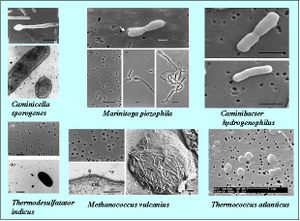User:Blomm013: Difference between revisions
| Line 22: | Line 22: | ||
==Ecology and Pathogenesis== | ==Ecology and Pathogenesis== | ||
Optimal growth conditions for ''T. atlanticus'' include temperatures between 55‹ | |||
Natural habitat (soil, water, commensal of humans or animals?)<br> | Natural habitat (soil, water, commensal of humans or animals?)<br> | ||
If relevant, how does this organism cause disease? Human, animal, or plant hosts? Important virulence factors, as well as patient symptoms. | If relevant, how does this organism cause disease? Human, animal, or plant hosts? Important virulence factors, as well as patient symptoms. | ||
Revision as of 21:39, 19 July 2013
Classification=
Bacteria; Thermodesulfobacteria; Thermodesulfobacteriales; Thermodesulfobacteriaceae; Thermodesulfatator
Thermodesulfatator atlanticus
Description and Significance
Thermodesulfatator atlanticus is a thermophile that was located in the walls of an active deep-sea hydrothermal vent on the Mid-Atlantic Ridge at Rainbow vent. Therefore, the species grows at extremely high temperatures. It was categorized as a Thermodesulfatator because it shares 97.8 % similarity with species that is representative of that genus, Thermodesulfatator indicus. Both species are anaerobic, chemolithoautotrophs, thermophiles, and sulfate reducers found in deep-sea hydrothermal vents. The two species do differ in a few key ways, however. T. indicus is strictly a chemolithoautotroph, where as T. atlanticus has the ability to use both inorganic and organic Carbon sources for energy. T. atlanticus is also able to survive in a wider range of pH conditions.
T. atlanticus was placed in the Thermodesulfobacteriacae family because of its' 16S rRNA gene sequences.
Give a brief description of the microorganism and explain why you think it is important. How does it relate to the other organisms in its phylum (bacteria and fungi) or group (archaea, virus, protist). Use the following for each reference in text (change number accordingly)--> [1]
Structure, Metabolism, and Life Cycle
Interesting features of its structure; how it gains energy (how it replicates, if virus); what important molecules it produces (if any), does it have an interesting life cycle?
Ecology and Pathogenesis
Optimal growth conditions for T. atlanticus include temperatures between 55‹
Natural habitat (soil, water, commensal of humans or animals?)
If relevant, how does this organism cause disease? Human, animal, or plant hosts? Important virulence factors, as well as patient symptoms.
References
[1] EXAMPLE ONLY. REPLACE WITH YOUR REFERENCES. Takai, K., Sugai, A., Itoh, T., and Horikoshi, K. 2000. "Palaeococcus ferrophilus gen. nov., sp. nov., a barophilic, hyperthermophilic archaeon from a deep-sea hydrothermal vent chimney". International Journal of Systematic and Evolutionary Microbiology. 50: 489-500. http://ijs.sgmjournals.org/cgi/reprint/50/2/489
Author
Page authored by _____, student of Mandy Brosnahan, Instructor at the University of Minnesota-Twin Cities, MICB 3301/3303: Biology of Microorganisms.

